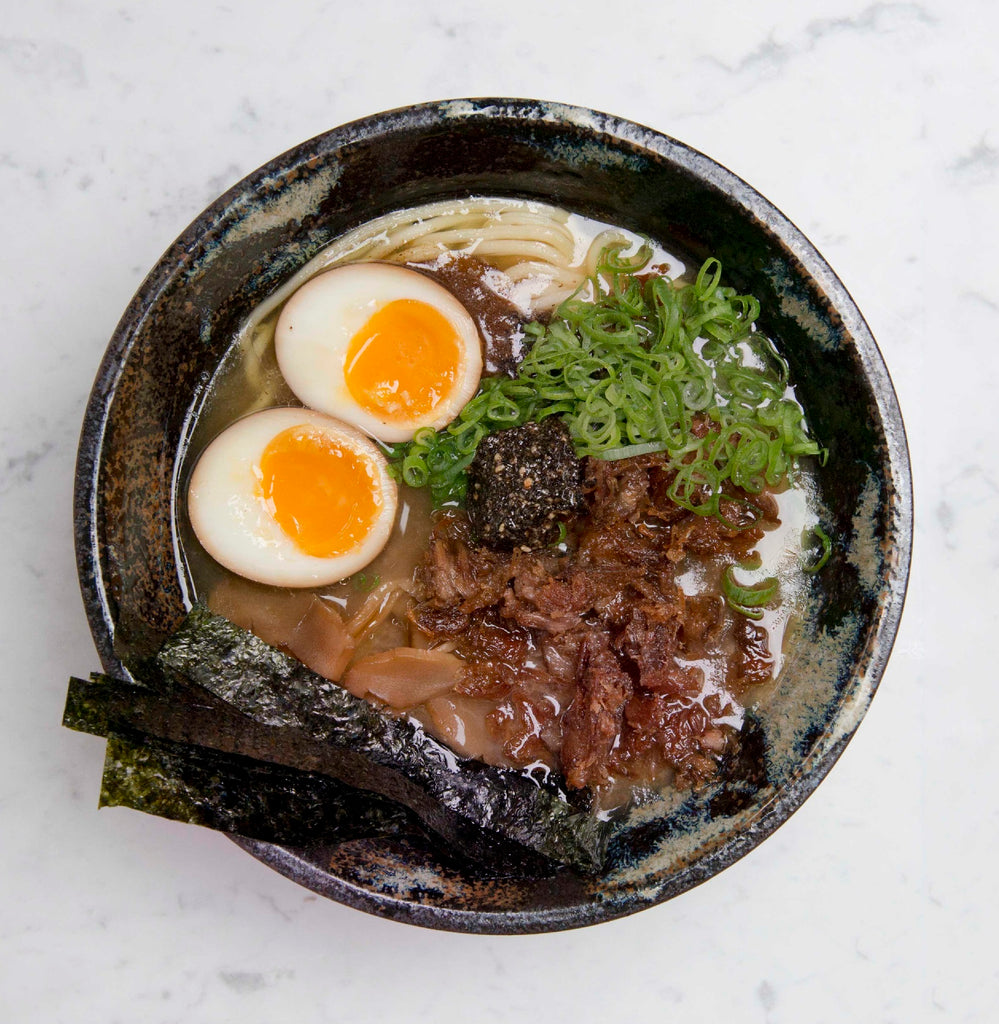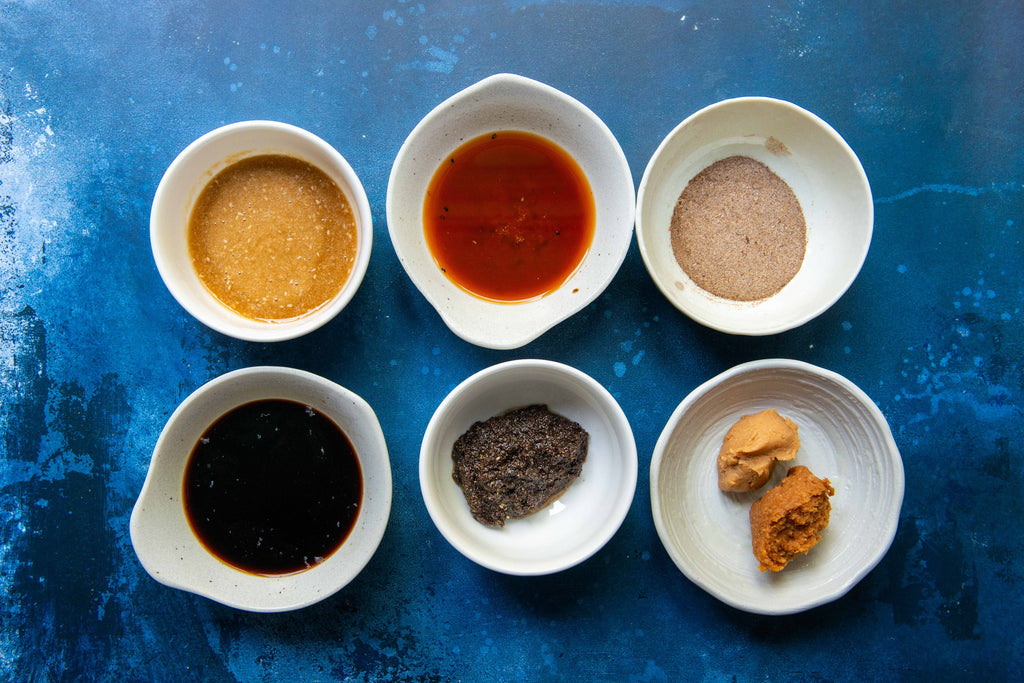What Is Ramen & Ramen Recipes To Make At Home

In the West, ramen suffers from a case of mistaken identity. Most people think they’ve tried ramen – the student staple, modestly priced and packed in shiny blocks or flimsy plastic cups on the supermarket shelf. But real ramen doesn’t come out of a packet with sachets of sauce. It is not cooked in a microwave for three minutes and it definitely isn’t freeze-dried. So, put aside the cheap instant ramen noodles - we’re going to use this article to focus on real ramen.
What is ramen?
Ramen is a Japanese noodle soup dish. It was inspired by noodle soups that Chinese immigrants brought to Japan in the late-19th century. The combination of warming, nutrient-rich broth and filling noodles won over Japan's working class, who found it the ideal meal to keep them satisfied during long days of physical labour.
These days, it's considered one of Japan's most popular 'fast foods'. Ramen restaurants are often quite small and open to the street, with lines of stools against a counter. People from all walks of life will sit down and slurp their way through a steaming hot bowl of ramen in minutes, before rushing off to go about their day.
In general, just-cooked ramen noodles sit in a soup or broth topped with chicken, pork belly, eggs, seaweed, dashi, spring onions and many other ingredients to create a slurp-worthy meal packed with plenty of lip-smacking umami. In Japan, ramen is pretty much a national obsession, with each area of the country declaring their style is the best.

Ramen almost always contains a stock that has been prepared hours, sometimes days, beforehand. Different ingredients can be added to the broth leading to an inexhaustible variety of different types of ramen. While each area of Japan will have their own ‘regional version’ of ramen, the variety of ways to customise the dish means that even individual shops will have their own unique ramen recipes.
Each style of ramen will differ in saltiness, richness, flavour and consistency. When a dish like this is open to so much modification, it also performs well in fusion cooking. With ramen, for example, other Asian countries like Thailand, Malaysia and Korea add their own twist. Indeed with so much room for adaptation, it would take a lifetime to cover all the varieties that make up this Japanese classic.
But there is one thing that all ramen across Japan has in common: it is made fresh every day, usually in the early hours before the shop opens. Its freshness, flavour and popularity mean that this is a dish that Japan takes very seriously.
In spite of this serious attitude, it's a dish that inspires people to constantly push the boundaries of what is considered ramen. The fun with ramen begins by making it in your own home where you can experiment with a wealth of ingredients to create a variation that suits you. In this article, we’ll break down what the constituents of ramen are and how to make the perfect cold season dish by yourself from scratch.
What are the different styles of ramen?
Ramen dishes are traditionally divided into three main categories, or styles, known as ‘tare’. This roughly translates as the salty, umami component of the dish which is used to season the ramen broth to a diner’s personal taste.
The three main tares are:
- Soy sauce (shoyu)
- Salt (shio)
- Miso
However, there is much more to each individual tare than simply salt, soy sauce or miso paste. Within each bowl of ramen will be a complex blend of anything from sake and vinegar to spices, garlic, ginger and oils. These are added to the main broth to create a huge variety of unique flavours.

As a general rule, ramen is made with 1 part tare to 10 parts broth or soup. The exception to this is miso tare - it's less salty than either shio tare or shoyu tare, so it's not uncommon to see as many as 5 parts miso to 10 parts broth.
1. Shoyu (soy sauce)
Shoyu tare is the oldest category and traditionally consists of chicken or vegetable stock combined with soy sauce. The result is a tangy, savoury flavour which can be combined with a variety of ingredients including seaweed, eggs, kamaboko (thinly sliced fish cakes with a pink swirl) and spring onions. Shoyu style chicken broth ramen is a classic in Tokyo, and it’s often served with thin, wavy ramen noodles.
2. Shio (salt)
Shio tare is the lightest style, and is generally chosen when you want the flavour of the broth to take centre stage. In Japan, ramen chefs will soak dried fish in water and season with extra salt to get their preferred level of saltiness. This is then mixed into the base ramen broth.
Classically, shio ramen consists of a pale, translucent broth where chicken, fish and/or vegetables are added. Like the shoyu, kamaboko is a popular topping as are the salty-fruity-sour Japanese pickled plums called umeboshi. Shio ramen is traditionally served with straight ramen noodles.
3. Miso
As suggested in the name, this type of ramen contains lots of miso paste, generally in a rich chicken or fish broth. Miso ramen can withstand robust flavours, so spicy bean pastes and chilli oils are popular additions together with a concoction of vegetables including cabbage, spring onions, leeks, corn and bean sprouts. The ramen noodles used are usually thick and chewy to create a ramen soup which is heavier than shoyu and shio.
You may also see a fourth type of tare - curry. Curry ramen is the relatively new kid on the block, first appearing in the mid-Sixties. Curry ramen is usually cooked with pork bones and curry leaves with thick and curly ramen noodles.
While these are the main groups, they barely scratch the surface of the myriad styles of ramen being made every day across Japan.
Noodles for ramen
Ramen isn't ramen without noodles. After the broth, the noodles are perhaps the most important component! Here are some popular Japanese noodles to have with ramen:
These noodles are cooked, cooled and vacuum packed to give a satisfyingly soft and chewy texture. Simply add to a simmering broth a few minutes before serving to allow the noodles to heat through. Pre-cooked ramen noodles like these are great for miso ramen.
Chuka-soba means Chinese-noodles. These are perhaps the closest to the original ramen noodles. This pack of Hime Chuka soba noodles comes divided into 8 handy bundles and each bundle serves 1-2 people. The slim, straight noodles are just what you want in a shio ramen.
Soba noodles are made from buckwheat flour (often with wheat flour too). Confusingly, 'soba' can not only mean noodles (as in Chuka-soba above), but it also means buckwheat in Japanese. Soba noodles are very thin, measuring around 1mm in width before cooking. Buckwheat noodles would be a great match for shio ramen.
Ramen noodles are often made with lye water to give them their distinctive yellow colour, and springy texture.

Ramen glossary
We know you're eager to get cooking! But before you get to the recipes, here are a few commonly used Japanese ramen ingredients and terms whose meanings are useful to know.
- Assari – a word used to describe ramen broths that are light and clear
- Beni Shoga – red ginger, used as a topping
- Chashu – Chinese-style pork belly very gently cooked in a sweet soy marinade, then sliced thinly to use as a ramen topping
- Dashi – a type of stock made from dry tuna flakes and/or seaweed
- Kaedama – an extra helping of ramen noodles
- Kamaboko – sliced fish cake usually with a frilled edge and a pink swirl
- Katsuoboshi bonito flakes – dried and smoked tuna flakes used to make dashi, or sprinkled as a topping
- Menma – lactate-fermented bamboo shoots
- Negi – spring onions
- Nori – dried seaweed
- Tare – the salty component to a ramen dish, made from soy sauce, miso or salt
- Renge – soup spoon used to slurp up ramen broth
- Tonkotsu – pork bone broth
Ramen noodle recipes
Now you're familiar with the lingo, it's time to start cooking. We have some classic ramen recipes on our blog, as well as lots of Japanese food ideas. Some of our favourites include:
Miso ramen– this recipe combines black garlic, sesame seed paste, mirin and sake to form an umami-driven, steaming bowl of yumminess. It’s perfect to wow guests at a dinner party but is just as good to enjoy on a winter’s night.
Tonkotsu ramen – the translation of tonkotsu is ‘pig bones’ which gives you some idea of the gutsy flavours involved. Simple ingredients power this dish and it’s a good idea to make plenty of the thick, gelatinous broth and freeze it for later - so you can enjoy a hearty tonkotsu ramen in under half the time!
Pork belly chashu – this recipe from Ivan Orkin helps you create the perfect chashu - Chinese-style pork belly very gently cooked in a sweet soy marinade. The blend of garlic, soy sauce, mirin and ginger come together to form a succulent pork belly topping which is the perfect partner to a steaming bowl of shio ramen.
To start your personal ramen journey, pick up one of our Japanese ramen bowl sets. They come with bowls, ladles, and an exclusive recipe booklet to guide you through each step. And find all the store cupboard ingredients you need in our dedicated Japanese ramen section of the store. Alternatively, read more about shirataki noodles here.





